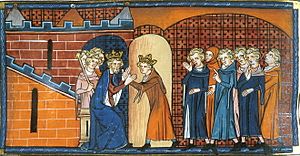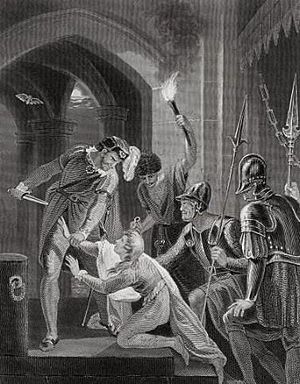Arthur I, Duke of Brittany facts for kids
Quick facts for kids Arthur I |
|
|---|---|

Arthur of Brittany as portrayed in a
genealogical roll in the British Library |
|
| Duke of Brittany | |
| Reign | 1196–1203 |
| Predecessor | Constance |
| Successor | Alix |
| Co-ruler | Constance (1196–2001) |
| Count of Anjou | |
| Reign | 1199–1203 |
| Predecessor | Richard I of England |
| Successor | John Tristan |
| Born | 29 March 1187 Nantes, Brittany |
| Died | presumed c. 1203 (aged 15–16) |
| House | Plantagenet |
| Father | Geoffrey II, Duke of Brittany |
| Mother | Constance, Duchess of Brittany |
Arthur I (born March 29, 1187 – died around 1203) was a young duke who played an important role in English and French history. He was the Duke of Brittany and Earl of Richmond from 1196 to 1203.
Arthur was born after his father, Geoffrey II, Duke of Brittany, had passed away. His mother was Constance, Duchess of Brittany. Arthur's grandfather was King Henry II of England.
In 1190, Arthur was chosen by his uncle, King Richard I, to be the next king of England. This meant Arthur would rule instead of Richard's younger brother, John. However, Arthur disappeared after being held in Rouen Castle in 1203. Most people believe he was killed by his uncle, King John.
Contents
Arthur's Early Life
Arthur was born in 1187. His father, Duke Geoffrey II of Brittany, died before Arthur was born. When Arthur was a baby, he was second in line to become king after his uncle, Richard. King Henry II, Arthur's grandfather, died when Arthur was two years old. Richard then became the new king.
While King Richard was away on a big journey called the Third Crusade, Arthur's mother, Constance, wanted Brittany to be more independent. In 1190, Arthur was named as Richard's chosen heir. He was also planned to marry a princess from Sicily. But this marriage never happened because of other events in Europe.
Another marriage plan for Arthur's older sister, Eleanor, also failed. In 1196, when Arthur was nine years old, his mother Constance made him the Duke of Brittany. They ruled together. That same year, King Richard asked Arthur and Constance to come to Normandy. But Arthur's stepfather, Ranulf de Blondeville, 6th Earl of Chester, took Constance away. Richard went to Brittany to help Arthur. However, Arthur was secretly taken to France to live with the French king's son, Louis.

King Richard died on April 6, 1199. Before he died, he named his brother, John, as his heir. Richard worried that Arthur was too young to rule and was too influenced by the French king. John quickly claimed the English throne. But many French nobles did not want John as their ruler. They preferred Arthur. Arthur then declared himself a vassal (a loyal supporter) of the French King Philip. King Philip agreed that Arthur had rights to lands like Anjou, Maine, and Poitou. After Richard's death, Arthur led his forces into Anjou and Maine. From April 18, he called himself Duke of Brittany, Count of Anjou, and Earl of Richmond.
Later, John convinced a powerful leader named William des Roches to switch sides. John said that Arthur would just be a puppet of the French king. A few days later, William took Arthur and Constance as prisoners. But then another leader, Viscount Aimery, helped Arthur and Constance escape to King Philip II's court.
The Treaty of Le Goulet
The Treaty of Le Goulet was an agreement signed by King John of England and King Philip II of France in May 1200. This treaty was supposed to settle who owned certain lands in France. Under this treaty, Philip recognized John as the King of England. This meant Philip stopped supporting Arthur's claim to the English throne. In return, John recognized Philip as the main ruler over his French lands.
Philip had previously said that John was the main ruler of Anjou and Brittany. But with this treaty, he made John pay a large sum of money to confirm John's rule over Brittany.
Fighting Against King John
After the Treaty of Le Goulet, Arthur felt upset with King Philip. He went to his uncle John, who treated him well at first. However, Arthur soon became suspicious of John and went back to Angers in France. Some reports say that in April 1202, Arthur was planned to marry Marie of France, a daughter of King Philip II.
After returning to France, Arthur started a military campaign against King John in Normandy in 1202, with Philip II's help. The region of Poitou also rebelled to support Arthur. Arthur then surrounded his grandmother, Eleanor of Aquitaine (who was John's mother), in a castle called Château de Mirebeau. King John quickly marched to Mirebeau and surprised Arthur on July 31, 1202. Arthur was captured by John's knights on August 1 and was put in prison at the Château de Falaise in Normandy.
Imprisonment and Disappearance
Arthur was guarded by Hubert de Burgh at the Chateau de Falaise. Hubert de Burgh was afraid of King John. He spread news that Arthur had died naturally. This news made the people of Brittany very angry, as they suspected Arthur had been killed. The next year, Arthur was moved to Rouen and was guarded by William de Braose. Arthur disappeared in April 1203. This happened while King Philip II of France was winning many battles against King John.
Many stories came out about Arthur's disappearance. One story said that Arthur's guards were afraid to hurt him, so King John himself killed Arthur.
William de Braose was also rumored to have killed Arthur. After Arthur disappeared, William de Braose became very favored by King John and received new lands. Many years later, William de Braose's wife, Maud de Braose, accused King John of killing Arthur.
No one, not even King Philip II, knew for sure what happened to Arthur or if he was alive or dead. Arthur did not have any known children.
Who Ruled Next?
The mystery around Arthur's death made it difficult to decide who would rule next. Both King John and King Philip II likely tried to influence this decision. Since Arthur had no sons, the next ruler had to be one of his sisters.
His sister, Eleanor, was also a prisoner of King John. Eleanor was a problem for John's plans for the English throne. Even though John allowed her to claim her rights to Brittany, she remained imprisoned for the rest of her life. She was held through the reign of John's son, Henry III of England. Eleanor never married or had children while she was imprisoned. Because she was held in England, she could not rule as the Duchess of Brittany.
Arthur I was eventually succeeded by his half-sister, Alix of Thouars. She was the daughter of Constance and her third husband, Guy of Thouars.
Arthur's Legacy

In Books and Stories
Arthur's death is a key part of Shakespeare's play The Life and Death of King John. In the play, Arthur is shown as an innocent child. His innocence stops Hubert de Burgh from killing him, as King John had ordered. But Arthur then dies while trying to escape.
Many other writers have also told stories about Arthur:
- The Breton poet Auguste Brizeux wrote about Arthur in La chasse du Prince Arthur.
- In the novel Saving Grace by Julie Garwood, the main character finds papers about Arthur's murder.
- In Randall Garrett's fantasy stories, Arthur becomes king and his family line continues.
- In The Devil and King John by Philip Lindsay, Arthur is killed by John in anger.
In Music
In 1912, the Breton composer Joseph-Guy Ropartz created a musical piece called La Chasse du Prince Arthur. The Breton folk-rock band Tri Yann also has a song about Arthur on their 1995 album Portraits.
On Television
Arthur and his mother Constance appear in the 1950s British TV show The Adventures of Robin Hood. Different actors played Arthur, including Peter Asher and Richard O'Sullivan. Simon Gipps-Kent also played Arthur in the 1978 BBC series The Devil's Crown.
Genealogical table
| Arthur's position within the English royal family | ||||||||||||||||||||||||||||||||||||||||||||||||||||||||||||||||||||||||||||||||||||||||||||||||||||||||||||||||||||||||||||||||||||||||||||||||||||||||||||||||||||||||||||||||||||||||||||||||||||||||||||||||||||||||||||||||||||||||||||||||||||||||||||||||||||||||||||||||||||||||||||||||||||||||||||||||||||||||||||||||||||||||||||||||||||||||||||||||||||||||||||||||||||||||||||||||||||||||||||||||||||||||||||||||||||||||||||||||||||||||||||||||||||||||||||||||||||||||||||||||||||||||||||||||||||||||||||||||||||||||||||||||||||||||||||||||||||||||||||||||||||||||||||||||||||||||||||||||||||||||||||||||||||||||||||||||||||||||||||||||||||||||||||||||||||||||||||||||||||||||||||||||||||||||||||||||||||||||||||||||||||||||||||||||||||||||||||||||||||||||||||||||||||||||||||||||
|---|---|---|---|---|---|---|---|---|---|---|---|---|---|---|---|---|---|---|---|---|---|---|---|---|---|---|---|---|---|---|---|---|---|---|---|---|---|---|---|---|---|---|---|---|---|---|---|---|---|---|---|---|---|---|---|---|---|---|---|---|---|---|---|---|---|---|---|---|---|---|---|---|---|---|---|---|---|---|---|---|---|---|---|---|---|---|---|---|---|---|---|---|---|---|---|---|---|---|---|---|---|---|---|---|---|---|---|---|---|---|---|---|---|---|---|---|---|---|---|---|---|---|---|---|---|---|---|---|---|---|---|---|---|---|---|---|---|---|---|---|---|---|---|---|---|---|---|---|---|---|---|---|---|---|---|---|---|---|---|---|---|---|---|---|---|---|---|---|---|---|---|---|---|---|---|---|---|---|---|---|---|---|---|---|---|---|---|---|---|---|---|---|---|---|---|---|---|---|---|---|---|---|---|---|---|---|---|---|---|---|---|---|---|---|---|---|---|---|---|---|---|---|---|---|---|---|---|---|---|---|---|---|---|---|---|---|---|---|---|---|---|---|---|---|---|---|---|---|---|---|---|---|---|---|---|---|---|---|---|---|---|---|---|---|---|---|---|---|---|---|---|---|---|---|---|---|---|---|---|---|---|---|---|---|---|---|---|---|---|---|---|---|---|---|---|---|---|---|---|---|---|---|---|---|---|---|---|---|---|---|---|---|---|---|---|---|---|---|---|---|---|---|---|---|---|---|---|---|---|---|---|---|---|---|---|---|---|---|---|---|---|---|---|---|---|---|---|---|---|---|---|---|---|---|---|---|---|---|---|---|---|---|---|---|---|---|---|---|---|---|---|---|---|---|---|---|---|---|---|---|---|---|---|---|---|---|---|---|---|---|---|---|---|---|---|---|---|---|---|---|---|---|---|---|---|---|---|---|---|---|---|---|---|---|---|---|---|---|---|---|---|---|---|---|---|---|---|---|---|---|---|---|---|---|---|---|---|---|---|---|---|---|---|---|---|---|---|---|---|---|---|---|---|---|---|---|---|---|---|---|---|---|---|---|---|---|---|---|---|---|---|---|---|---|---|---|---|---|---|---|---|---|---|---|---|---|---|---|---|---|---|---|---|---|---|---|---|---|---|---|---|---|---|---|---|---|---|---|---|---|---|---|---|---|---|---|---|---|---|---|---|---|---|---|---|---|---|---|---|---|---|---|---|---|---|---|---|---|---|---|---|---|---|---|---|---|---|---|---|---|---|---|---|---|---|---|---|---|---|---|---|---|---|---|---|---|---|---|---|---|---|---|---|---|---|---|---|---|---|---|---|---|---|---|---|---|---|---|---|---|---|---|---|---|---|---|---|---|---|---|---|---|---|---|---|---|---|---|---|---|---|---|---|---|---|---|---|---|---|---|---|---|---|---|---|---|---|---|---|---|---|---|---|---|---|---|---|---|---|---|---|---|---|---|---|---|---|---|---|---|---|---|---|---|---|---|---|---|---|---|---|---|---|---|---|---|---|---|---|---|---|---|---|---|---|---|---|---|---|---|---|---|---|---|---|---|---|---|---|---|---|---|---|---|---|---|---|---|---|---|---|---|---|---|---|---|---|---|---|---|---|---|---|---|---|---|---|---|---|---|---|---|---|---|---|---|---|---|---|---|---|---|---|---|---|---|---|---|---|---|---|---|---|---|---|---|---|---|---|---|---|---|---|---|---|---|---|---|---|---|---|---|---|---|---|---|---|---|---|---|---|---|---|---|---|---|---|---|---|---|---|---|---|---|
|
||||||||||||||||||||||||||||||||||||||||||||||||||||||||||||||||||||||||||||||||||||||||||||||||||||||||||||||||||||||||||||||||||||||||||||||||||||||||||||||||||||||||||||||||||||||||||||||||||||||||||||||||||||||||||||||||||||||||||||||||||||||||||||||||||||||||||||||||||||||||||||||||||||||||||||||||||||||||||||||||||||||||||||||||||||||||||||||||||||||||||||||||||||||||||||||||||||||||||||||||||||||||||||||||||||||||||||||||||||||||||||||||||||||||||||||||||||||||||||||||||||||||||||||||||||||||||||||||||||||||||||||||||||||||||||||||||||||||||||||||||||||||||||||||||||||||||||||||||||||||||||||||||||||||||||||||||||||||||||||||||||||||||||||||||||||||||||||||||||||||||||||||||||||||||||||||||||||||||||||||||||||||||||||||||||||||||||||||||||||||||||||||||||||||||||||||
See also
 In Spanish: Arturo I de Bretaña para niños
In Spanish: Arturo I de Bretaña para niños


